1968: A Road Show
Odyssey
|
Read more
at in70mm.com The 70mm Newsletter |
| Written and compiled by: Michael Coate | Date: May 29, 2004 |
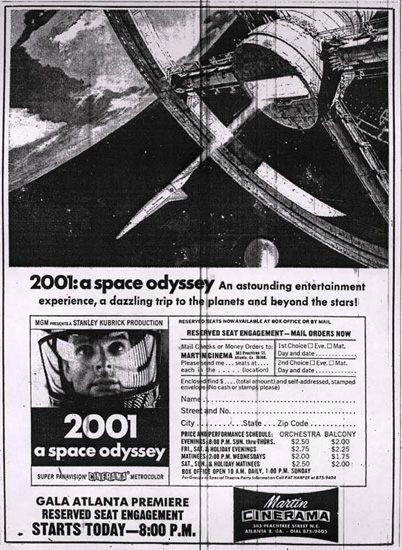 "2001" newspaper advertisement. Ads of this type appeared in
major city newspapers in advance of release and throughout the engagement.
This one is advertising the Atlanta, Georgia engagement. Note the reserved
seat ticket order form. "2001" newspaper advertisement. Ads of this type appeared in
major city newspapers in advance of release and throughout the engagement.
This one is advertising the Atlanta, Georgia engagement. Note the reserved
seat ticket order form.
Stanley Kubrick’s “2001: A Space Odyssey” had its world premiere on 2 April 1968 at the Uptown Theatre in Washington, D.C. Thus began an interesting 70mm odyssey. The critically acclaimed film had what is believed to have been a record number of 70-millimeter wide gauge prints made for a film during the roadshow era. Included here is a nostalgic and historical look back at the original engagements. • Go to Showcase Presentations in Washington, DC The original reserved seat release of “2001” played for many, many weeks in cinemas all around the world, with engagements exceeding one year being quite common. In some cities, the film’s engagement even reached two years. In Los Angeles, for instance, the film played for 103 weeks as an area exclusive. In addition to the successful roadshow release and subsequent general release, the film has been re-released numerous times, with the official United States re-releases occurring in 1974, 1977, 1980, and, are you surprised, 2001. • Go to 2OO1: A Space Odyssey - Release dates However, the film has, essentially, never been out of release. Between general release, revival runs, return engagements, retrospectives, festival screenings, midnight screenings, and even drive-in engagements (yes, “2001: A Space Odyssey” has screened in 70mm format at a drive-in), Kubrick’s award-winning science-fiction epic has been seen on the large cinema screen — where it no doubt plays best — virtually every year since its original release. Over the years, “2001” has quite possibly been shown in the high-quality 70mm format more times than any other film. One of the most recent 70mm screenings was held in Bradford, England in summer 2003 during the Widescreen Cinema Conference held at the National Museum of Photography, Film & Television. Metro-Goldwyn-Mayer placed a tremendous amount of confidence in Stanley Kubrick and his vision, and during 1968 in support of the release there were more than one hundred 70mm reserved seat engagements throughout the world (the majority of which are accounted for in engagement list). It seems that practically any city with a Cinerama theatre played the film, and by the late 1960s, at its peak, there were more than 150 cities with at least one such venue. (With rare exception, post-1963 Cinerama was Cinerama in name-only. Post-’63 Cinerama is recognized to be single-strip 70mm, not the original 35mm/six-perf three-strip format.) Many other 70mm-equipped, non-Cinerama cinemas played the film in 1968, promoting the film in “regular” 70mm rather than Cinerama. “2001” was put into 35mm general release beginning in autumn 1968. |
Further
in 70mm reading: "2OO1: A Space Odyssey" in Super Panavision 70, Cinerama and 6-track Stereo Sound A Big Screen Odyssey: The 70mm Presentations of Kubrick’s “2001” "2001" release dates Warner Bros. Pictures Celebrates 50 Years of Stanley Kubrick's "2001: A Space Odyssey" Comments to The Original Reserved Seat Engagements Of ‘2001: A Space Odyssey’ Stanley Kubrick's "2OO1: A Space Odyssey" in Super Panavision 70 "2001:A Space Odyssey" Yet another soundtrack Full credits for "2001:A Space Odyssey" "2001" A Concert Article |
Interesting factoids |
|
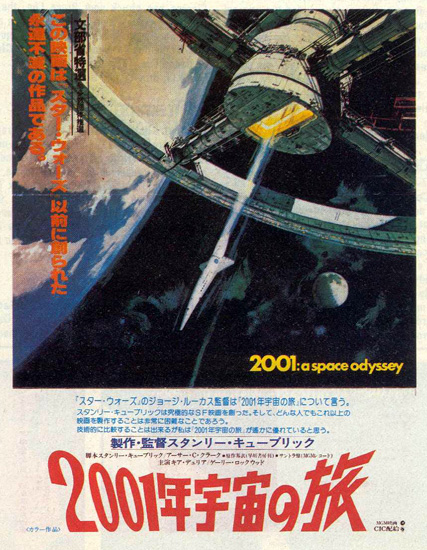 Japanese
advert. in70mm.com collection Japanese
advert. in70mm.com collection“2001” is ranked number 22 on the American Film Institute’s Top 100 movies of all-time. In 2002, Philips Electronics and Martin Scorsese’s The Film Foundation selected it as one of the fifteen “Best Widescreen Films”. The film’s collective U.S. & Canada box office gross, following a handful of engagements during the 2001/2002 re-release, is reported to be $56.9 million, while the film’s U.S. & Canada box office “rental” (the portion of the gross returned to the distributor based on the booking terms — typically an average of about 50 to 60 percent ) was $25.5 million through 1996. The film’s worldwide gross exceeds $100 million. Those figures, of course, represent the film’s entire theatrical exhibition history — 70mm, 35mm, and 16mm. On 4 April 1968, a couple of days following the world premiere of “2001,” civil rights leader Dr. Martin Luther King, Jr. was assassinated in Memphis, Tennessee. Following some civil unrest and thousands of arrests, several cities were assigned a curfew, resulting in some theatres, including the District of Columbia’s Uptown Theatre where “2001” was playing, being dark for a few days. In spring 1969, “2001” was awarded its only Oscar. (The film received four nominations in total.) The Oscar, for Visual Effects, was awarded to producer/director/co-screenwriter Kubrick, who had also been credited as the film’s Special Photographic Effects Designer and Director. As a result of having the award given solely to Kubrick, some have felt that the contributions of the landmark film’s special photographic effects supervisors — Wally Veevers, Douglas Trumbull, Con Pederson, Tom Howard — and crew were overlooked by the Academy. |
|
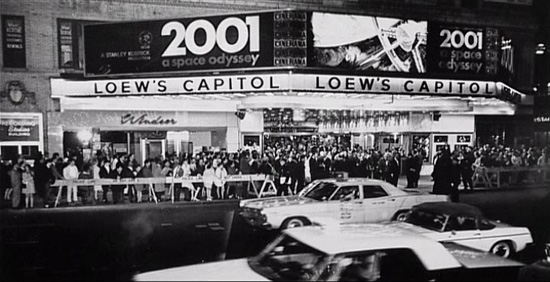 Loew's
Capitol Theatre in New York City. Copyright 2001 Warner Bros. Loew's
Capitol Theatre in New York City. Copyright 2001 Warner Bros.Over the years, prints of “2001” have been prepared in a variety of audio formats, including magnetic stereo prints in both 35mm and 70mm at a time when few movies were mixed and released in a multichannel format. The film’s original 70mm prints were in the so-called Todd-AO channel layout (left/left-center/center/right-center/right/surround), which was standard at the time. Contemporary 70mm prints of “2001” have utilized Dolby SR noise reduction and have been made available in the original Todd-AO channel layout, as well as in the modern-day “5.1”-channel configuration (left/center/right/left-surround/right-surround/LFE). There have been reports that at least one 70mm print prepared for the 2001/2002 re-release was in the DTS-70 digital sound format, though sources at Warner Bros. (the current distributor of the film) have denied that such prints were available. (Recent 35mm prints have included Dolby SR/Dolby Digital/DTS/SDDS. The DVD versions have Dolby Digital 5.1-channel sound.) Perhaps most interesting is that following several film critics bemoaning the slow pace of the film and excessive running time, Kubrick — perhaps reluctantly — cut about 20 minutes from the film (and added some location ID titles). Variety’s film review noted MGM’s initial print order for “2001” being just over 100, prompting some to wonder: if all of those (expensive) prints had been struck from a two and one-half-hour-plus negative prior to the revisions, did the studio order new replacement prints from the re-cut negative, or was each print that had already been struck physically re-cut by a projectionist or studio representative to conform to the new, shorter negative? |
|
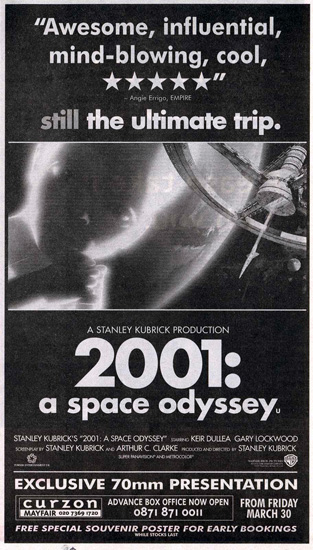 March
30, 2001 re-release advert from London. in70mm.com collection March
30, 2001 re-release advert from London. in70mm.com collectionA contemporary audience may think that making changes to a film is a recent phenomenon. It was common in previous decades (just not as widely publicized), and, in the case of roadshows, it was not uncommon for films to be shortened during their transition from reserved seat run to general release. Some roadshow releases, however, including the classics “Lawrence Of Arabia” (1962) and “Doctor Zhivago” (1965), were shortened during the initial hard ticket, reserved seat release. What makes the changes interesting in the case of “2001” is that it appears, at least initially, that the film was not re-printed. Rather, the changes were made directly on each already-struck print. One may wonder how many days and in which cities audiences saw the original cut before being replaced with the shorter version. Given the production timeline and the distribution sequence, it appears that the initial three cities in which the film was publicly screened — Washington D.C., New York, and Los Angeles — began showing the original-length version. The book “The Making Of 2001” cites the shortened cut appearing for the first time on 6 April 1968. Variety, however, reported in a 17 April article that the original three cities, plus Boston, started their runs with the long version. If Boston indeed initiated their engagement with the long version, it is conceivable that the other few engagements that began on the same day as Boston (10 April; see engagement list) also showed the long cut to a paying audience before being replaced with the revised edition. (A film review published in the Harvard Crimson included a reference to the Boston Cinerama Theatre’s print having been physically altered, referring to it as a “splice-ridden rough-cut”.) Some might ponder how the press would have reacted to the film had they been shown the tightened, revised edition. During this age of director’s cuts and deleted scenes — special features popular on the DVD format — “2001: A Space Odyssey” continues to be seen today only in its shorter 149-minute edition. (The running time is 139 minutes plus about ten minutes of roadshow components: overture, intermission, exit music.) "2001" Original Reserved Seat Engagement List |
|
References |
|
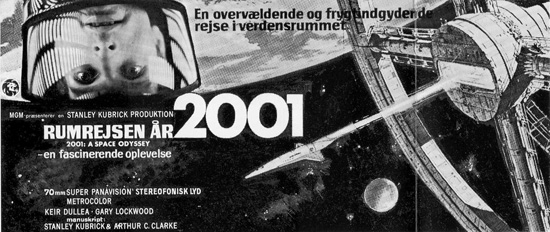 Danish
1969 70mm release advert. in70mm.com collection Danish
1969 70mm release advert. in70mm.com collectionGeneral research was conducted in the trade publications Boxoffice, The Hollywood Reporter, and Variety; the magazine Widescreen Review; the Internet newsgroup rec.arts.movies.tech; the websites www.boxofficemojo.com, www.cinerama.topcities.com, and www.in70mm.com; and the books “Box Office Hits” (Susan Sackett, Billboard, 1996), “Show Houses: Twin Cities Style” (Kirk J. Besse, Victoria, 1997), “Motor City Marquees: A Comprehensive, Illustrated Reference To Motion Picture Theaters In The Detroit Area, 1906-1992” (Stuart Galbraith IV, McFarland, 1994), and “The Making Of 2001: A Space Odyssey” (The Modern Library, 2000). Specific details have been principally referenced from daily newspapers archived on microfilm, and the following: - “$2 Mil ‘Odyssey’ B.O. Gross To Date”. Variety, 7 June 1968. - “2001: A Space Odyssey”. Film Review. Variety, 3 April 1968. - “2001: In 35m Version”. Film Review. Variety, 15 Jan 1969. - “2001 Gross Passes $13 Mil”. The Hollywood Reporter, 18 October 1968. - Box Office Mojo - Kretzel, Bill. “Cinerama And Large-Frame Motion Picture Exhibition In Canada”. - “Kubrick Trims ‘2001’ By 19 Mins., Adds Titles To Frame Sequences; Chi, Houston, Hub Reviews Good”. Variety, 17 April 1968. - “Making Of 2001: A Space Odyssey, The”. The Modern Library, 2000. - “Stanley Kubrick: A Life In Pictures”. Documentary film. Warner Home Video DVD 21158, 2001. |
|
Special Thanks |
|
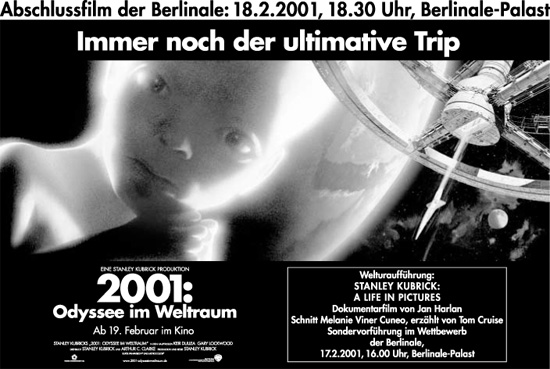 German
2001 re-release artwork. in70mm.com collection German
2001 re-release artwork. in70mm.com collectionSerge Bosschaerts Evans A. Criswell Philip Croft Carlos Fresnedo Jean-Pierre Gutzeit Hans Haenssler Dr. Sheldon Hall Thomas Hauerslev William Kallay Bill Kretzel David Lascelles Roland Lataille Richard L. Lenoir Mark Lensenmayer Paul Linfesty Jose Gonzalez Mancera Ilene Montana Jan E Olsen Sebastian Rosacker Dr. Jochen Rudschies Sam Shapiro Christian Smith Grant Smith Wendy Thomas If you wish to provide feedback or contribute to this list, please contact Michael Coate or Thomas Hauerslev. |
|
|
Go: back
- top - back issues
- news index Updated 22-01-25 |
|
